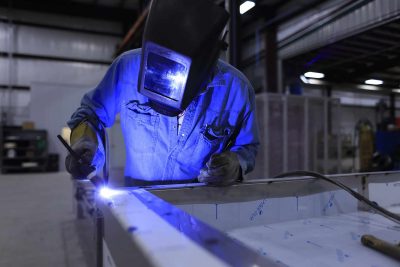Welding fumes have been considered a threat to workers for a long time. Inhaling the fumes produced from welding techniques pose a serious danger to the workers’ health. Respiratory problems often occur in patients categorised under the profession of a welder. However, in recent times, ever-evolving analytic techniques give medical representatives enough data to come to the frightening conclusion that inhaling welding fumes can even pose life-threatening disease, like lung and kidney cancer. Such disease can be observed in patients that were prolonged exposed to welding fumes from various metals.
In correlation with recent findings, the HSE has updated their welding regulations, with a bulletin being first announced in early 2019. Those HSE regulations serve as a tool to demand employers to provide protective equipment to their workers, that can keep the exposure to fumes to a much lower degree, thus allowing them to stay healthy in disregard to their otherwise dangerous profession.
Since the initial announcement there has now also been some new HSE guidance and advice for employers to properly educate their staff in safe methods of working, that will further limit the exposure to toxic fumes while they perform their daily work. Specifically around mild steel welding.
Who is most often exposed to welding fumes.
Welding is a manufacturing technique required in a large amount of operations in many commercial facilities. The key difference is that some workers may be exposed throughout the entirety of their working day, while others indulge in welding activities for a couple of hours a week. Mostly while performing repairing jobs to various products or equipment. For example, a worker that is employed as a welder in a metal construction site will most likely weld for more than a half of his day, and the rest of the time he will be sourcing various materials, moving equipment around or planning his next welding job. On the other hand, a mechanic in a car repair shop will perform different types of welding for only a couple of hours a week. Regardless of the lengths of time spent welding, without controls in place, workers will be exposed to welding fumes. The most effective way to reduce exposure to welding fumes is to capture it at source, protecting the welder and preventing fumes from spreading.
HSE guidance notes also include the protection of other individuals present in the property in which welding operations take place. Although they may not be performing welding operations, there is still a chance of exposure to welding fumes. Because of this, the HSE welding guidance includes the state of the overall ventilation of the property. This will be a key point in their routine checks, alongside the proper training of welders, about how to safely do their jobs and properly operate the equipment, and the presence or lack of LEV systems (where mandatory).
For further information about controlling the risks from welding, visit the HSE official site, here you can also find some more information on the potential risks from exposure.
Commercial grade weld fume extraction filters, extraction benches and LEV systems can be found at Ducting Express. Any information you might need to choose the correct equipment for your needs, you can find one phone call away 01455 616444. The experienced and knowledgeable customer care representatives on the other side of the phone will happily aid you through the selection of protective equipment.
